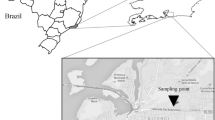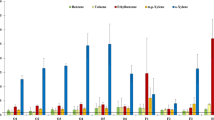Abstract
Background, Aim and Scope
Formaldehyde and acetaldehyde are emitted by many mobile and stationary sources and secondary aldehydes are intermediates in the photo-oxidation of organic compounds in the atmosphere. These aldehydes are emitted indoors by many materials such as furniture, carpets, heating and cooling systems, and by smoking. Carbonyls, mainly formaldehyde and acetaldehyde, have been studied because of their adverse health effects. In addition, formaldehyde is a suspected carcinogen. Therefore, the concentrations of formaldehyde and acetaldehyde were determined to assess the inhalation exposure doses to carbonyls for people who work in a 13-story building and in order to evaluate the cancer hazard.
Methods
Carbonyl compounds in indoor and outdoor air were measured at a 13-story building located in Mexico City. The mezzanine, fifth and tenth floors, and the third level-parking garage were selected for sampling. Samples were collected in two sampling periods, the first from April 20 to 29, 1998 and the second from December 1 to 20, 1998. Carbonyls were sampled by means of DNHP-coated cartridges at a flow rate of 1 1 min-1 from 9:00 to 19:00 hours, during 2-hour time intervals and analyzed by HPLC with UV/VIS detection.
Results
Mean carbonyl concentrations were highest in the 3rd level-parking garage, with the formaldehyde concentration being the highest ranging from 108 to 418 ug m-3. In working areas, the highest carbonyl arithmetic mean concentrations (AM) were observed on the 5th floor. Acetone and formaldehyde concentrations were highest in April ranging from 161 to 348 µg m5 (AM = 226) and from 157 to 270 µg m-3 (AM= 221), respectively. Propionaldehyde and butyraldehyde were present in smaller concentrations ranging from 2 to 25 and 1 to 28 µg m-3, respectively, considering all the samples. Mean indoor/outdoor ratios of carbonyls ranged from 1.8 to 9.6. A reduction of inhalation exposure doses of 41% and 45% was observed in the fifth floor air after the air conditioning systems had been repaired. Formaldehyde and acetaldehyde concentrations were higher in smoking environments.
Conclusion
Indoor carbonyl concentrations were significantly greater than outdoor concentrations. Tobacco smoke seems to be the main indoor source of formaldehyde. After the air conditioning system was maintained and repaired (as was recommended), an important reduction in the emission of formaldehyde and acetaldehyde was achieved on all floors, except for the 3rd level parking garage, thereby reducing the inhalation exposure doses.
Recommendation
The results obtained in this research demonstrated that maintenance of air conditioning systems must be carried out regularly in order to avoid possible adverse effects on health. Additionally, it is mandatory that isolated smoking areas, with air extraction systems, be installed in every public building.
Similar content being viewed by others
References
A5TSDR (Agency for Toxic Substances and Disease Registry). Public Health Assessment Guidance Manual http://www.atsdr.cdc.gov
Báez A, Padilla H, Garcia R, Torres MC, Rosas I, Belmont R (2003): Carbonyl levels in indoor and outdoor air in Mexico City and Xalapa, Mexico. The Science of the Total Environment 302, 211–226
Caldwell JC, Woodruff TJ, Morello-Frosh R, Axerad DA (1998): Application of health information of hazardous air pollutants modeled in EPA’s cumulative exposure project. Toxicol Ind Health 14, 429–454
Carlier P, Hannachi H, Mouvier G (1986): The chemistry of carbonyl compounds in the atmosphere - A review. Atmospheric Environment 20, 2079–2099
Granby K, Christensen CS, Lohse C (1997): Urban and semi-rural observations of carboxylic acids and carbonyls. Atmospheric Environment 31, 1403–1415
Grosjean E, Williams II EL, Grosjean D (1993): Ambient levels of formaldehyde and acetaldehyde in Atlanta, Georgia. J Air Waste Manage Assoc 43, 469–474
Guering MR, Jenkings RA, Tomkings BA (1992): The chemistry of environmental tobacco smoke: composition and measurements. Indoor Air Research Series, Eisenberg M (ed), Ann Arbor Lewis Publishers
Hansen SJ, Burroughs HE (1999): Managing Indoor Air Quality. The Fairmont Press, Inc., Lilburn, GA, Prentice Hall Hispanoamericana, S.A., México, p. 2–3
Ho KF, Lee SC, Louie PKK, Zou SC (2002): Seasonal variation of carbonyl compound concentrations in urban area of Hong Kong. Atmospheric Environment 36, 1259–1265
Leaderer BP, Hammond SK (1991): Evaluation of vapor-phase nicotine respirabie suspended particle mass as markers for environmental tobacco smoke. Environ Sci Technol 25, 770–777
Lee SC, Chang M, Chan KY (1999): Indoor and outdoor air quality investigation at six residential buildings in Hong Kong. Environ Int 25 (4) 489–496
Liu JZ, Liu YC, Hu HS, Hao IY (1990): Characteristics of rural indoor formaldehyde pollution in China. In: Indoor Air 90. Proceedings of the fifth International Conference on Indoor Air Quality and Climate 2, 725–730
Miguel AH, Aquino Neto FR, Cardoso JN, Vasconcellos P, Pereira AS, Marquez KSG (1995): Characterization in indoor air quality in the cities of São Paulo and Rio de Janeiro, Brazil. Environ Sci Technol 29, 338–345
Muramarzu S, Matsumara T, Okamoto S. (1990): The ratio of indoor and outdoor measurements of nitrogen dioxide and formaldehyde. In: Indoor Air 90, Proceedings of the Fifth International Conference on Indoor Air Quality and Climate. Toronto, Canada 2, 561–564
Rosenbaum AS, Axeirad DA, Woodruff TJ, Wei YH, Ligocki MP, Cohen JP (1999): National estimates of outdoor air toxics concentrations. J Air Waste Manage Assoc 49, 1138–1152
U.S. EPA (1991a): Integrated Risk Information System (IRIS) on formaldehyde. On-line IRIS, CASRN 50-00-0
U.S. EPA (1991b): Integrated Risk Information System (IRIS) on acetaldehyde. On-line IRIS, CASRN 75-07-0
US CPSC (US Consumer Product Safety Commission) (1997): An update on formaldehyde: Revision. Washington, DC; CPSC Document # 75
US EPA (1994a): Health Effects Notebook for Hazardous Air Pollution Office of Air Quality Planning and Standards. Formaldehyde. Technology Transfer Network Air Toxics Website, Fact Sheet 50-00-0, EPA-452/D-95-003
US EPA (1994b): Health Effects Notebook for Hazardous Air Pollution Office of Air Quality Planning and Standards. Acetaldehyde. Technology Transfer Network Air Toxics Website, Fact Sheet 75-07-0, EPA-452/D-95-003
Waters (1994): Sep-Pack DNPH-Silica cartridges: care and use Manual, Water Corporation, Milford MA
Zhang J, He Q, Lioy PJ (1994): Characteristics of aldehydes: concentrations sources, and exposures for indoor and outdoor residential microenvironments. Environ Sci Technol 28, 146–152
Zhang J, Smith KR (1999): Emissions of carbonyl compounds from various cookstoves in China. Environ Sci Technol 33, 2311–2320
Author information
Authors and Affiliations
Corresponding author
Rights and permissions
About this article
Cite this article
Báez, A.P., Padilla, H.G., García, R.M. et al. Measurements of carbonyls in a 13-story building. Environ Sci & Pollut Res 11, 400–404 (2004). https://doi.org/10.1007/BF02979660
Received:
Accepted:
Issue Date:
DOI: https://doi.org/10.1007/BF02979660




